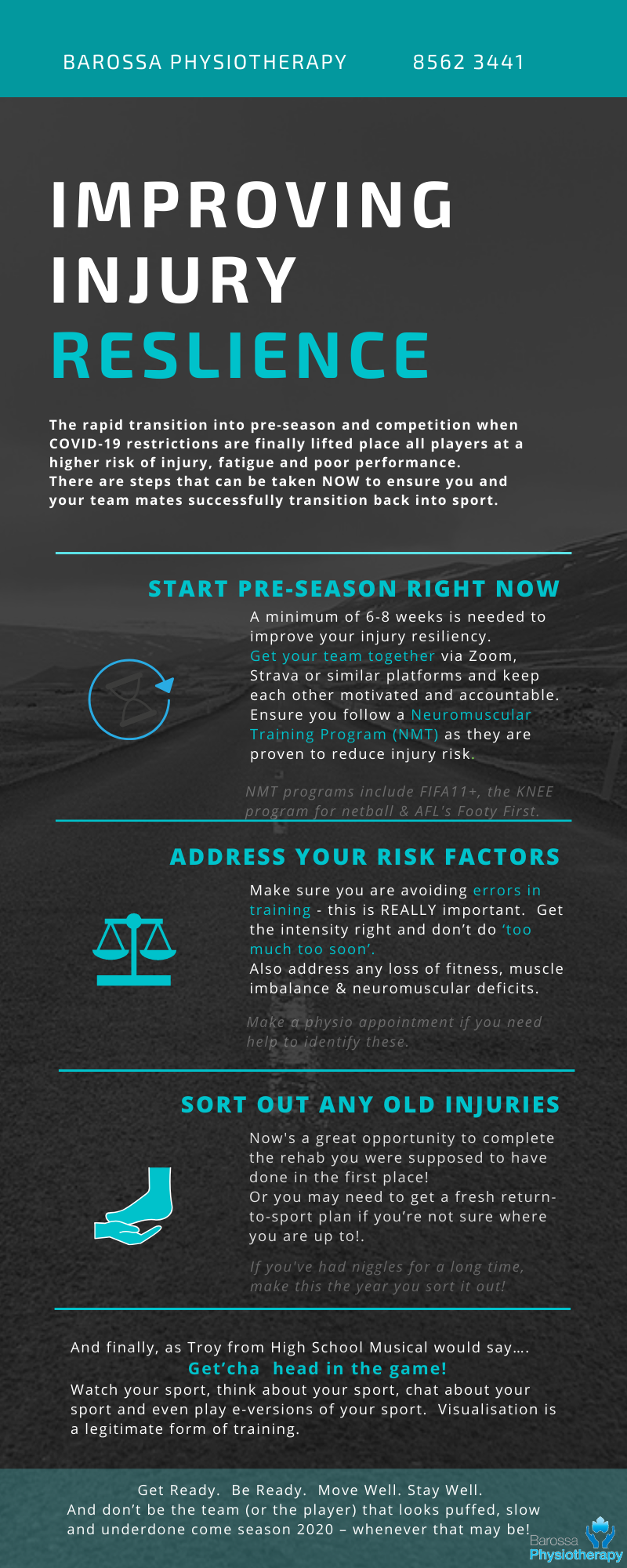Exercise Deficit Disorder – a threat to our successful return to sport after lockdown.
- Melissa Smith
- May 7, 2020
- 3 min read
Who else can’t wait to get back to sport!!
My household is certainly keen - one 20 year old boy is desperate to return to training and playing with his mates, dad is sick of watching “8 out of 10 Cats does Countdown” instead of footy and this mum misses the catch-ups and cheering with the Ladies in the Grandstand. I am even yearning for a schnitzel with gravy and going home smelling like the chip fryer!!!
However…this mum (who’s also a physio) is also a tad worried and it’s not only the Corona Virus that needs to be managed – it’s because of a phenomenon coined:
“Exercise Deficit Disorder” Reference
Whilst it’s in no way as critical as the actual health risk that the Corona Virus poses, nor as decimating as current and potential financial consequences, the danger to sports people returning from extended time away is very real.
The potential rapid re-entry into sport always rang alarm bells for me, as we know that a lot of players will have struggled to self-motivate to keep in shape. A bit of research led me to a surprisingly similar situation in the US. Both the NBA and NFL experienced an ‘unprecedented’ lockdown (they called it lockout) during player/owner disputes. In 2011 both codes experience 5-8 months of non-play and no training as teams. This period has given us some great insights into what we may face in terms of injury profiles, and an opportunity to prevent some of the issues those codes faced.
The circumstances were similar to current COVID times – an uncommon off-season, a shortened pre-season and a rapid transition into the initiation of competition.
So what did they see?
More Achilles tendon ruptures for the NFL in the first 2 weeks of the new pre-season than the entire year before (10 in the first 12 days, where the usual average for a whole year was 8).
A change in the timing of the injuries – more occurring in the pre-season period rather in the playing season.
An increase in the NBA for ACL injuries, attributed at least in part to the lockout period of 2011.
Younger NFL players and rookies carried more of the injury burden:
Pre-lockout Achilles rupture – average player was aged 29 yrs, with 6 years NFL experience.
Post-lockout Achilles rupture – average player was aged 23.9 yrs, with 1.4 years NFL experience.
Players with previous injury and/or surgery were at higher risk of re-injury after the lockout than before – probably due to some residual biomechanical or neuromuscular deficits and for some an insufficient rehab due to the lockout process.
https://www.ncbi.nlm.nih.gov/portal/utils/pageresolver.fcgi?recordid=5eb2545484ced466f2f79c8a; https://simplifaster.com/articles/sports-return-performance-vs-injury/
According to Derek Hanson and Robert Panariello, physios and conditioning specialists from simplifaster.com, this was because the players had less Injury Resiliency!
Why?
"Deconditioning"
This causes:
Increases in the risk of overuse soft tissue injury
Excessive fatigue and inability to maintain optimal and consistent physical and mental performance during high intensity sessions.
And this in turn leads to:
Decreased strength (including explosive strength)
Poor reactivity to the ground surface (impacting agility)
Decreased kinesthetic and proprioceptive awareness (foot and hand placement at speed)
Decreased on-task concentration (just ask a junior coach how difficult this can be normally!!)
Decreased capacity to recover – both in between each drill and between each training or game.
Or in plainer English –
...they don’t perform as well, and they get hurt more easily!!
Also, the rapid transition has pressures of it’s own:
Decreased contact time with coaches and other support people
Shortened coaching time
More pressure to “get more done in less time”
Decreased access to medical staff (including physio)
Increase in relative re-injury risk for those with prior injury
Most importantly, though, is what can be done? We have created a great infographic that will hopefully motivate and direct you to Move Well and Stay Well.






